London Chess Classic 2013 begins with Super 16 in Rapid Format
Chess Blog for Daily Chess News and Trivia (c) Alexandra Kosteniuk, 2013
Hello everyone,
Here is the London Chess Classic 2013: Super 16 Rapid update (excerpts), by John Saunders, on Rounds 1 and 2 played on Wednesday.
After the opening ceremony, with brilliant Norwegian guitarist Alf Wilhelm Lundberg playing his own arrangement of ‘Chestnuts’ for all of us chess nuts, it was straight down to action. Rapid chess is,of course, a very different beast from classical (or longplay) chess. At this, the highest level, the opening and early middlegame can be played with as much accuracy as a classical game but sooner or later the limited thinking time puts the players under huge pressure and this can cause a huge swing in fortunes, much as in a blitz game. This proved to be the case at the Classic right from the start, as we shall see.
Replay all the games of both the rounds with Chess King.
ROUND 1
Anyone predicting a result based on computer assessments after 20 or 30 moves of the first batch of four games would probably have only got one of the four results right. Mickey Adams himself demurred when asked if he was better all the way but his win looked the least problematic of the first four games on the stage as he took on the FIDE Open qualifier Andrei Istratescu from France, who no doubt struggled to make the transition after four days of tough classical chess.
The 15th World Champion Vishy Anand, playing his first game since Chennai, was definitely in severe trouble against Luke McShane as the world’s strongest amateur played swooped to win rook for knight. But, in the inevitable time pressure, Luke made a poor move (31.Ke2 – see the accompanying PGN file), Vishy’s pawns suddenly became massively strong and Luke crumbled.
ROUND 2
Hello everyone,
Here is the London Chess Classic 2013: Super 16 Rapid update (excerpts), by John Saunders, on Rounds 1 and 2 played on Wednesday.
This year’s main event at the London Chess Classic, the Super Sixteen Rapid, began at 1400 at the Olympia Conference Centre, with the elite players playing at a rate of 25 minutes for all the moves, plus ten seconds added per move. They are divided up into four groups of four, with the top two qualifying for a final knock-out phase. The point system is, as usual at the Classic, 3 points for a win and 1 for a draw.
After the opening ceremony, with brilliant Norwegian guitarist Alf Wilhelm Lundberg playing his own arrangement of ‘Chestnuts’ for all of us chess nuts, it was straight down to action. Rapid chess is,of course, a very different beast from classical (or longplay) chess. At this, the highest level, the opening and early middlegame can be played with as much accuracy as a classical game but sooner or later the limited thinking time puts the players under huge pressure and this can cause a huge swing in fortunes, much as in a blitz game. This proved to be the case at the Classic right from the start, as we shall see.
Replay all the games of both the rounds with Chess King.
ROUND 1
Anyone predicting a result based on computer assessments after 20 or 30 moves of the first batch of four games would probably have only got one of the four results right. Mickey Adams himself demurred when asked if he was better all the way but his win looked the least problematic of the first four games on the stage as he took on the FIDE Open qualifier Andrei Istratescu from France, who no doubt struggled to make the transition after four days of tough classical chess.
The 15th World Champion Vishy Anand, playing his first game since Chennai, was definitely in severe trouble against Luke McShane as the world’s strongest amateur played swooped to win rook for knight. But, in the inevitable time pressure, Luke made a poor move (31.Ke2 – see the accompanying PGN file), Vishy’s pawns suddenly became massively strong and Luke crumbled.
In the commentary room Vishy quipped “It was an embarrassing game,” but quickly added “I’d take an embarrassing win over a beautiful loss any time.” Well, I guess that is a lesson we amateurs could teach the professionals as we play embarrassing games rather more often they do. It was actually a very instructive game, showing the value of resilience under pressure and also that, at rapid chess, there is no such thing as a ‘won game’.
Vishy wasn’t the only world champion to turn his game around. Vladimir Kramnik did much the same against Peter Svidler. Vlad tried a tactic (19.Nxc7) which he later admitted was a mistake as it marginally lost material (two pieces for rook and pawn) but he managed to generate enough counterplay to force his opponent into time trouble and finally blunder.
Vishy wasn’t the only world champion to turn his game around. Vladimir Kramnik did much the same against Peter Svidler. Vlad tried a tactic (19.Nxc7) which he later admitted was a mistake as it marginally lost material (two pieces for rook and pawn) but he managed to generate enough counterplay to force his opponent into time trouble and finally blunder.
Matthew Sadler managed to win two knights for a rook against Scottish number one Jonathan Rowson but he allowed his opponent’s queen and rook to maintain a powerful pin on the seventh rank. That shouldn’t have been good enough to win but Jonathan eventually had two connected passed pawns and it proved too hard to defend in the time available.
The rounds are played in two shifts of four games, so now Groups C and D took the stage. It proved very tough for Emil Sutovsky to make the transition from classical to rapid chess in one day (bear in mind that he had already played four tough games before the other guys started), and his attempt to do something unusual in the opening backfired against Fabiano Caruana, and the brilliant Italian super-GM made no mistake.
Gawain Jones’s first game was against the world number three rapidplay player, Hikaru Nakamura, rated 2812 at rapid chess. (In case you were wondering who the two players above Hikaru on the rapid list are... surprise, surprise, Magnus Carlsen, rated 2845 at this form of the game, and Russian superstar Alexander Grischuk, 2828.) So it was a particularly valiant effort for Gawain to draw against Hikaru. An interesting position cropped up on move 50: Jones - Nakamura, Round 1, after 49...Bc6
Here Gawain played 50.Qd4, to which Hikaru replied 50...e5!, opening the path for his queen to come to h3 and threaten mate on g2 or h1. Gawain replied 51.Qxe5 (there’s nothing better) and here Hikaru should have played the crushing intermezzo move 51...Re8!! before putting his queen on h3. Instead he went there immediately – 51...Qh3? – and Gawain was able to block the diagonal with 52.Rd5! If Hikaru takes the rook, he would actually lose so he had to retreat his queen. Thereafter Gawain had rather the better of it but it wasn’t enough to win.
Nigel Short’s homebrew opening seemed to throw David Howell off course slightly, but the crowd of English GMs in the VIP room, where Nigel’s illustrious contemporary Julian Hodgson holds sway, were a bit disappointed when he didn’t go all in with something other than 9.Qxe6 in the opening. Thereafter he played steadily to secure a draw.
Judit Polgar was made to pay for a slight inaccuracy (14...Nbd7) in the opening against Boris Gelfand, who won a pawn and exploited it calmly and efficiently as if it were a classical game.
The rounds are played in two shifts of four games, so now Groups C and D took the stage. It proved very tough for Emil Sutovsky to make the transition from classical to rapid chess in one day (bear in mind that he had already played four tough games before the other guys started), and his attempt to do something unusual in the opening backfired against Fabiano Caruana, and the brilliant Italian super-GM made no mistake.
Gawain Jones’s first game was against the world number three rapidplay player, Hikaru Nakamura, rated 2812 at rapid chess. (In case you were wondering who the two players above Hikaru on the rapid list are... surprise, surprise, Magnus Carlsen, rated 2845 at this form of the game, and Russian superstar Alexander Grischuk, 2828.) So it was a particularly valiant effort for Gawain to draw against Hikaru. An interesting position cropped up on move 50: Jones - Nakamura, Round 1, after 49...Bc6
Here Gawain played 50.Qd4, to which Hikaru replied 50...e5!, opening the path for his queen to come to h3 and threaten mate on g2 or h1. Gawain replied 51.Qxe5 (there’s nothing better) and here Hikaru should have played the crushing intermezzo move 51...Re8!! before putting his queen on h3. Instead he went there immediately – 51...Qh3? – and Gawain was able to block the diagonal with 52.Rd5! If Hikaru takes the rook, he would actually lose so he had to retreat his queen. Thereafter Gawain had rather the better of it but it wasn’t enough to win.
Nigel Short’s homebrew opening seemed to throw David Howell off course slightly, but the crowd of English GMs in the VIP room, where Nigel’s illustrious contemporary Julian Hodgson holds sway, were a bit disappointed when he didn’t go all in with something other than 9.Qxe6 in the opening. Thereafter he played steadily to secure a draw.
Judit Polgar was made to pay for a slight inaccuracy (14...Nbd7) in the opening against Boris Gelfand, who won a pawn and exploited it calmly and efficiently as if it were a classical game.
There’s little respite for the players in rapid chess and the first batch of players were back on stage again four hours after their first games. Vlad Kramnik won his second game of the day, using his trusty Réti to overcome Jonathan Rowson. That doesn’t quite tell the story of the game as Vlad rather overstretched his position in the opening. However, Jonathan’s little combination to simplify the position backfired. He played 24...Ncxa4, which he himself later described as “wildly optimistic” – he thought he should have played 24...Qe6. This slip allowed Vlad to get a grip on the position, which, typically, he never let go.
Anand-Adams was cagey but accurate and a draw ensued. Luke McShane, probably disappointed at not snaring Vishy in the first game, came back strongly in round two against Andrei Istratescu. A tactic to exchange a couple of pawns (15.e5) looked innocent enough but Julian Hodgson was alive to its potential. He pointed out the general vulnerability of Black’s kingside pawn structure minus the h7 pawn. Luke was alive to this possibility, too. Andrei tried to create counterplay with 25...f3 but Luke’s attack crashed through. Even so it might have been averted had Andrei challenged the white queen with ...Qf6 at a couple of junctures.
Anand-Adams was cagey but accurate and a draw ensued. Luke McShane, probably disappointed at not snaring Vishy in the first game, came back strongly in round two against Andrei Istratescu. A tactic to exchange a couple of pawns (15.e5) looked innocent enough but Julian Hodgson was alive to its potential. He pointed out the general vulnerability of Black’s kingside pawn structure minus the h7 pawn. Luke was alive to this possibility, too. Andrei tried to create counterplay with 25...f3 but Luke’s attack crashed through. Even so it might have been averted had Andrei challenged the white queen with ...Qf6 at a couple of junctures.
On the grounds that everyone likes to see a good old-fashioned checkmate, here is the denouement:
McShane - Istratescu, Round 2, after 29.h5 Here Black’s last chance was 29...Qf6 but instead he played 29...Rf6? to which 30.Bg6! was the crushing reply. The only way to stop what actually followed would have been to play 30...Qf4, but that simply loses the bishop on d7. Instead Black fell on his sword with 30...Bc6, allowing the attractive 31.Qh6+!. Black resigned as 31...gxh6 32.Rh7 would be mate.
Svidler-Sadler was a very exciting draw, with the players attacking on opposite flanks. Matthew’s dangerous queenside attack goaded Peter into a piece sacrifice on g6, which wasn’t too far from being a win. Peter flung a second piece into the maelstrom but that proved only good enough to draw.
Despite the high tactical content, the players didn’t seem to miss anything when you compare their moves with silicon.
Svidler-Sadler was a very exciting draw, with the players attacking on opposite flanks. Matthew’s dangerous queenside attack goaded Peter into a piece sacrifice on g6, which wasn’t too far from being a win. Peter flung a second piece into the maelstrom but that proved only good enough to draw.
Despite the high tactical content, the players didn’t seem to miss anything when you compare their moves with silicon.
That just left the four games of the 7.30pm ‘night shift’. Nigel Short decided to entertain the crowd (and perhaps discomfit his Italian super-GM opponent) with 1.b4 (Note that Nigel started with 1.c4 in his first round game, so it might be worth having a little flutter at the bookie’s on him trying 1.a4 in his next game with White.). The 1.b4 opening is known variously as the Sokolsky, Polish or Orangutan opening but this one soon might have been dubbed a reversed St George’s Defence, as developed by IM Mike Basman and famously used by Tony Miles (as Black) to defeat a reigning world champion, Anatoly Karpov. Short followed up with a little light Basmania on the kingside, but there was to be no dragon-slaying today. Fabiano Caruana smoothly developed his pieces and established a solid positional plus. Nigel’s shaky pawn structure proved his undoing and he quickly slid downhill to defeat. In a later tweet he said, “yesterday’s warm-up is over. Now it is time for me to wake up.”
Judit Polgar has had an even stickier start, losing both her games. In round 2 she was up against a determined Hikaru Nakamura, desperate to get his first three-pointer in the bag. Judit gradually came adrift after the inaccurate 37.Re1.
Judit Polgar has had an even stickier start, losing both her games. In round 2 she was up against a determined Hikaru Nakamura, desperate to get his first three-pointer in the bag. Judit gradually came adrift after the inaccurate 37.Re1.
Emil Sutovsky admitted at the press conference that he much prefers the longer form of the game. He did seem to have a chance to repeat positions but opted not to, playing perhaps a bit too boldly and then getting his rook snared.
The final game to finish was Gelfand-Jones, coming down to a tricky knight endgame. The pundits thought Gawain might just get away with his suspect position but Boris was implacable and found a way to win, even after it came down to N+P v N.
The final game to finish was Gelfand-Jones, coming down to a tricky knight endgame. The pundits thought Gawain might just get away with his suspect position but Boris was implacable and found a way to win, even after it came down to N+P v N.
More fun tomorrow!
SCORES AFTER ROUND 2
Group A: Adams, Anand 4, McShane 3, Istratescu 0.
Group B: Kramnik 6, Rowson 3, Sadler, Svidler 1.
Group C: Gelfand 6, Nakamura 4, Jones 1, Polgar 0.
Group D: Caruana 6, Howell 4, Short 1, Sutovsky 0.
Group A: Adams, Anand 4, McShane 3, Istratescu 0.
Group B: Kramnik 6, Rowson 3, Sadler, Svidler 1.
Group C: Gelfand 6, Nakamura 4, Jones 1, Polgar 0.
Group D: Caruana 6, Howell 4, Short 1, Sutovsky 0.
COMING NEXT AT THE LONDON CLASSIC...
Super Sixteen Rapid rounds 3 and 4 take place on Thursday 12 December 2013, starting at 1400 UK time. There are three further sessions at 1530, 1800 and 1930.
Super Sixteen Rapid rounds 3 and 4 take place on Thursday 12 December 2013, starting at 1400 UK time. There are three further sessions at 1530, 1800 and 1930.
Check all the action at the London Chess Classic 2013 live at the official website.
From Alexandra Kosteniuk's
www.chessblog.com
Also see her personal chess blog
at www.chessqueen.com
Don't miss Chess Queen™
YouTube Channel
www.chessblog.com
Also see her personal chess blog
at www.chessqueen.com
Don't miss Chess Queen™
YouTube Channel
Labels: london chess classic 2013






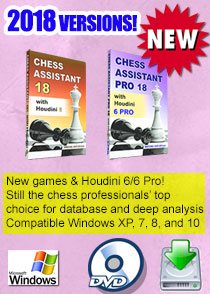























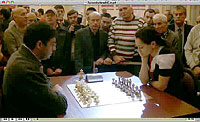
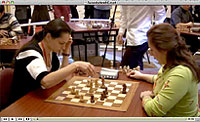
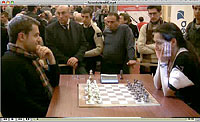

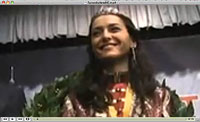

0 Comments:
Post a Comment
Note: Only a member of this blog may post a comment.
Subscribe to Post Comments [Atom]
<< Home